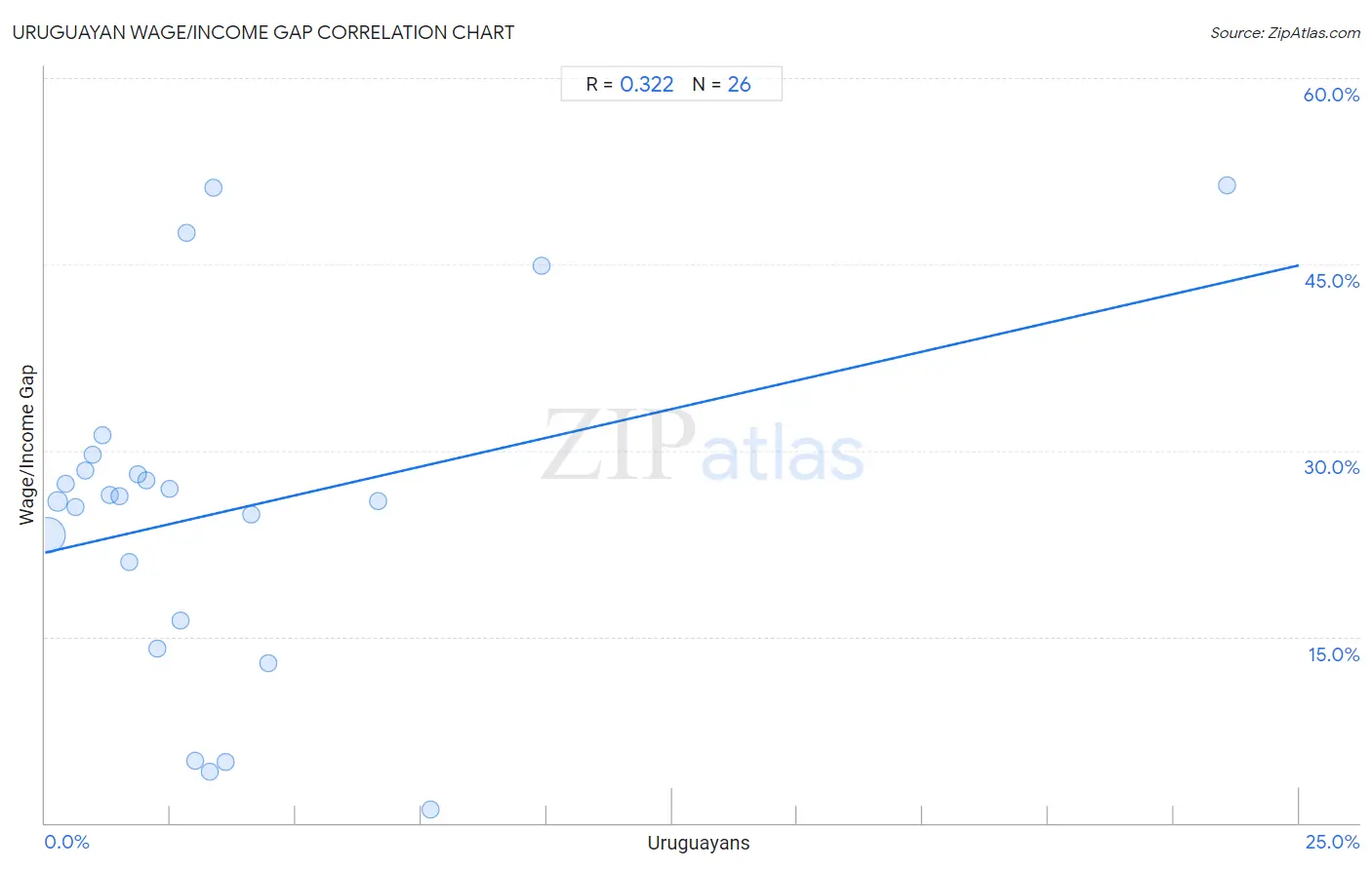Uruguayan Wage/Income Gap
COMPARE
Uruguayan
Select to Compare
Wage/Income Gap
Uruguayan Wage/Income Gap
25.2%
WAGE/INCOME GAP
81.3/ 100
METRIC RATING
152nd/ 347
METRIC RANK
Uruguayan Wage/Income Gap Correlation Chart
The statistical analysis conducted on geographies consisting of 144,770,221 people shows a mild positive correlation between the proportion of Uruguayans and wage/income gap percentage in the United States with a correlation coefficient (R) of 0.322 and weighted average of 25.2%. On average, for every 1% (one percent) increase in Uruguayans within a typical geography, there is an increase of 0.93% in wage/income gap percentage.

It is essential to understand that the correlation between the percentage of Uruguayans and wage/income gap percentage does not imply a direct cause-and-effect relationship. It remains uncertain whether the presence of Uruguayans influences an upward or downward trend in the level of wage/income gap percentage within an area, or if Uruguayans simply ended up residing in those areas with higher or lower levels of wage/income gap percentage due to other factors.
Demographics Similar to Uruguayans by Wage/Income Gap
In terms of wage/income gap, the demographic groups most similar to Uruguayans are Taiwanese (25.1%, a difference of 0.030%), Immigrants (25.1%, a difference of 0.11%), Immigrants from Peru (25.1%, a difference of 0.16%), Iroquois (25.1%, a difference of 0.30%), and Blackfeet (25.2%, a difference of 0.32%).
| Demographics | Rating | Rank | Wage/Income Gap |
| Comanche | 85.2 /100 | #145 | Excellent 25.0% |
| South Americans | 85.2 /100 | #146 | Excellent 25.0% |
| Malaysians | 84.9 /100 | #147 | Excellent 25.0% |
| Iroquois | 83.9 /100 | #148 | Excellent 25.1% |
| Immigrants from Peru | 82.6 /100 | #149 | Excellent 25.1% |
| Immigrants | 82.3 /100 | #150 | Excellent 25.1% |
| Taiwanese | 81.6 /100 | #151 | Excellent 25.1% |
| Uruguayans | 81.3 /100 | #152 | Excellent 25.2% |
| Blackfeet | 78.1 /100 | #153 | Good 25.2% |
| Immigrants from Northern Africa | 78.1 /100 | #154 | Good 25.2% |
| Immigrants from Vietnam | 77.7 /100 | #155 | Good 25.2% |
| Immigrants from Mexico | 76.4 /100 | #156 | Good 25.3% |
| Costa Ricans | 75.8 /100 | #157 | Good 25.3% |
| Immigrants from Zimbabwe | 73.7 /100 | #158 | Good 25.3% |
| Puget Sound Salish | 73.0 /100 | #159 | Good 25.3% |
Uruguayan Wage/Income Gap Correlation Summary
| Measurement | Uruguayan Data | Wage/Income Gap Data |
| Minimum | 0.040% | 1.1% |
| Maximum | 23.6% | 51.4% |
| Range | 23.5% | 50.3% |
| Mean | 3.6% | 25.1% |
| Median | 2.4% | 26.1% |
| Interquartile 25% (IQ1) | 1.1% | 16.3% |
| Interquartile 75% (IQ3) | 3.6% | 28.4% |
| Interquartile Range (IQR) | 2.5% | 12.1% |
| Standard Deviation (Sample) | 4.7% | 13.5% |
| Standard Deviation (Population) | 4.6% | 13.2% |
Correlation Details
| Uruguayan Percentile | Sample Size | Wage/Income Gap |
[ 0.0% - 0.5% ] 0.040% | 126,094,254 | 23.1% |
[ 0.0% - 0.5% ] 0.25% | 11,801,880 | 25.9% |
[ 0.0% - 0.5% ] 0.42% | 2,735,734 | 27.3% |
[ 0.5% - 1.0% ] 0.61% | 1,673,075 | 25.5% |
[ 0.5% - 1.0% ] 0.80% | 871,313 | 28.4% |
[ 0.5% - 1.0% ] 0.94% | 519,332 | 29.7% |
[ 1.0% - 1.5% ] 1.13% | 223,890 | 31.2% |
[ 1.0% - 1.5% ] 1.29% | 256,015 | 26.4% |
[ 1.0% - 1.5% ] 1.48% | 237,582 | 26.3% |
[ 1.5% - 2.0% ] 1.67% | 133,798 | 21.0% |
[ 1.5% - 2.0% ] 1.85% | 71,071 | 28.1% |
[ 2.0% - 2.5% ] 2.02% | 52,551 | 27.6% |
[ 2.0% - 2.5% ] 2.23% | 69,004 | 14.1% |
[ 2.0% - 2.5% ] 2.48% | 6,811 | 26.9% |
[ 2.5% - 3.0% ] 2.69% | 1,747 | 16.3% |
[ 2.5% - 3.0% ] 2.83% | 1,659 | 47.5% |
[ 2.5% - 3.0% ] 3.00% | 1,067 | 5.0% |
[ 3.0% - 3.5% ] 3.28% | 1,250 | 4.1% |
[ 3.0% - 3.5% ] 3.36% | 506 | 51.2% |
[ 3.5% - 4.0% ] 3.61% | 887 | 4.9% |
[ 4.0% - 4.5% ] 4.11% | 7,496 | 24.8% |
[ 4.0% - 4.5% ] 4.46% | 830 | 12.9% |
[ 6.5% - 7.0% ] 6.63% | 4,553 | 25.9% |
[ 7.5% - 8.0% ] 7.69% | 611 | 1.1% |
[ 9.5% - 10.0% ] 9.89% | 3,114 | 44.9% |
[ 23.5% - 24.0% ] 23.56% | 191 | 51.4% |